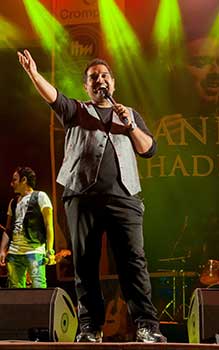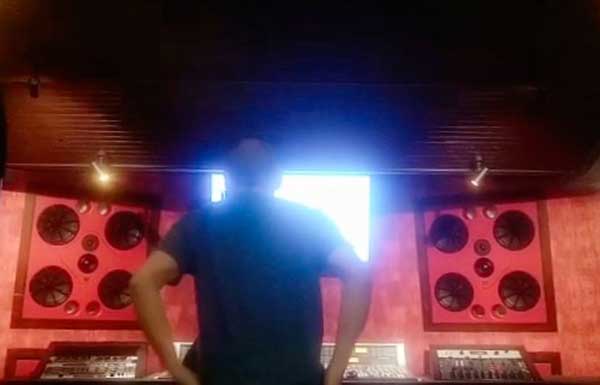Shankar and Siddharth Mahadevan’s Lambodara Studios – Leaves you Breathless

Auroville based leading acoustic consultancy & audio video system design firm Sound Wizard was tasked with designing acclaimed singer, composer and music director Shankar Mahadevan’s new studio. In this article, Sound Wizard gives PT the lowdown. Watch out for the July-August issue for Studio Pics.
Situated in Navi Mumbai, Shankar and Siddharth Mahadevan’s stunning new facility Lambodara Studios has been built to the latest international acoustic standards and interior design trends. Within the stylish “Bollywood-jazz” interiors of this first floor studio, form follows function, with no compromise to either. The attention to detail in acoustic and interior design has resulted in a comforting and pleasing mixing and recording environment that fosters and encourages creativity at the highest level. The genesis of Lambodara Studios began in 2019 with a WhatsApp message from Siddharth Mahadevan, after his visit to Island City Studios (a Sound Wizard project) in Khar West, Mumbai; ”Just visited Island City Studios a couple of days ago... NICE WORK! Listen, I’m building my own studio here in Mumbai and I want you guys to design it.”
The Design Process
The civil shell of the building had already been constructed with this purpose in mind, so the Sound Wizard team began the design process by working on possible layouts to accommodate a main control room, live recording area, reception, machine rack, bathrooms and an administrative area in the space. The critical task of taking the original civil blueprints of the building, cross checking and correcting them with precise on-site measurements fell to Sound Wizard’s architect Mehul Kumar. Along with acoustician Didier Weiss, Mehul worked on the complex puzzle of fitting all the aforementioned areas into the 100m2 (1075ft2) shell. Once a tentative layout was approved by the client, Sound Wizard began detailed interior acoustics, isolation and system design for the space.
The usual challenges of designing a professional studio in Mumbai presented themselves early on, including a low, flat ceiling and parallel walls. Equally important, Sound Wizard needed to find space to accommodate a complicated ducted air conditioning system that would satisfy cooling requirements in Mumbai while remaining virtually silent. After much deliberation, Sound Wizard formulated an unorthodox yet simple solution to combat the space constraints. The control room and the recording space were placed side by side, as opposed to the more usual front-to-back orientation. The reward for this clever thinking was threefold; it opened up extra floor space, created plenty of visual contact between the recording room and control room, and freed up space on the front baffle-wall between the main studio monitor loudspeakers for a large video display.
Since the client had complete faith in the acoustic design prowess of Sound Wizard, they were allowed to put together a coherent design, un-spoilt by the common practice of “design by committee” that usually results in a compromised outcome. Succinctly put by Didier Weiss, “When a concept is simple, then the outcome is often efficient and harmonious.”
Design Features
As with any Sound Wizard project, high quality acoustic design aided by EASE simulation was the key to unlocking the full potential of the space. Transparency is the main goal of any recording studio design, and Lambodara Studios has multiple acoustic features that help it achieve this goal. The front baffle wall of the control room acts as a waveguide to redirect the energy from the flush-mounted Quested Q412D monitors QSB118 subwoofers. The glazing between the recording room and control room (for visual access) is built up of 3 panes and has been angled vertically within the control room to prevent first reflections from interfering with the direct sound and colouring the signal. To create symmetry in the room, mirrors have been placed on the opposite wall (to the glazing) to simulate the acoustic performance of glazing, resulting in a perfect stereo image at the listening position. A combination of custom-designed diaphragmatic absorbers as well as ceiling and side-wall absorbers have been used to eliminate modal issues (standing waves) and create a flat reverberation-time curve at all frequencies. Both the control room and recording area have also been designed within “floating” shells, “room within a room” designs that reduce sound transmission through structural vibration.
The custom designed honeycomb diffusers in the control room are a fantastic example of collaboration between client, consultant and interior designer. While Sound Wizard had initially planned to use QRD (Quadratic Residue Diffuser) or slat diffusers, Siddharth Mahadevan preferred a complex honeycomb diffuser instead. Using software simulation to determine the form and dimensions required to diffuse sound at a targeted frequency range, Sound Wizard was able to provide interior designer Kiran Shetty with the framework to turn a functional acoustical device into an eye-catching interior and lighting design element. Acoustically, the device achieves its target of scattering mid and high frequencies to minimise comb filtering at the listening position while also creating a more pleasant and “live” listening environment.

Shankar Mahadevan seen here with his sons Shivam (L) and Siddharth (R) at their new studio Lambodara
HVAC System
An often overlooked and under-appreciated feature of a professional recording studio is the heating, ventilation and air conditioning (HVAC) system design. Lambodara Studios is divided into two independent air conditioning zones. The most critical area, the recording room, meets an NC15 noise level target. The (slightly) less critical environment, the control room, meets an NC20 noise level target. Having two independent AC setups lowers the machine noise levels, mitigates sound transmission between separate spaces and also offers better control over energy consumption. Sound Wizard devised the concept layout and detailing for the duct work, which was further developed and adapted by the HVAC vendor in their final system design.

The Main Control Room: Didier Weiss doing the final system and room optimization of the powerful baffle mounted Quested studio monitoring
| Lambodara Studios Technical Specification |
| Studio size: |
100m2 (1075ft2) |
| Control room: |
33m2. (355ft2) |
| Recording space: |
30m2. (300ft2) |
| Main monitoring: |
Quested Q412D |
| Subwoofers: |
Quested QSB118 |
| Near field: |
Barefoot MicroMain 26 |
| Mixing console: |
SSL AWS 948 |
| Software: |
AVID ProTools & Logic Pro X |
| Pre-amp: |
Neve 4081, Lexicon PCM & Chandler Limited TG12411 |
| Interface: |
Universal Audio Apollo X16 & Universal Audio Teletronix LA-2A |
| Equaliser: |
Manley Massive Passive |
| Compressors: |
Universal Audio UAD 1176, Dangerous Music & API 2500 |
| Microphones: |
Neumann U87, Brawner MV1 & AKG C12VR |
| Cabling: |
Sommer Cable |
| Acoustic design: |
SOUND WIZARD; www.soundwizard.net |
Implementation
Translating a consultant’s vision into reality is the most critical part of the process, and a failure to pay attention to detail at this stage results in a massive waste of time and money. Especially when it comes to sound isolation, any mistakes made during the construction of a “floating” shell results in issues that are difficult and often impossible to rectify. The smallest of leaks in a shell can compromise its entire function, resulting in wasted material, space, time and money.
The construction team Ashok Interiors was recruited to implement the sound isolation and acoustic interior design had previously worked on Island City Studios in Mumbai, the studio that brought Sound Wizard to the notice of Mahadevan. Although using skilled labourers with some experience installing acoustical materials helped, it is always challenging for a construction team to get to grips with complex technical drawings. Sound Wizard had to follow up with multiple on-site meetings to ensure a seamless build-out. It always helps to have a design team with plenty of local experience and a client willing to understand that consultant site visits save time and money in the end because fewer mistakes are made. The design team can then ensure quality control and clearly answer questions to the on-site craftsmen, taking local methods and materials into account.
Lambodara Studios is a first-class example of how one can morph square block city construction into an excellent professional music facility without going overboard. Understanding the importance of acoustics and a commitment to detail are key elements that guarantee a speedy and cost effective studio project. Thanks to a fantastic partnership between client and consultant, Lambodara Studios sets a new benchmark in India as a modern, state-of-the-art recording studio that will be relevant in the Indian music scene for years to come.
Sign-off
Completing the circle, this project started with an enthusiastic WhatsApp, and befittingly also comes to a successful completion with a message of appreciation.
“Hi Didier, ... just wanted to tell you that this is by far the best studio I have heard and am so thankful to you and your team for doing such a fabulous job! We really feel proud having this studio of serious quality and aesthetics! Thanks once again and hope to see you sometime soon!!”
Shankar Mahadevan (client sign-off WhatsApp - March 2020)